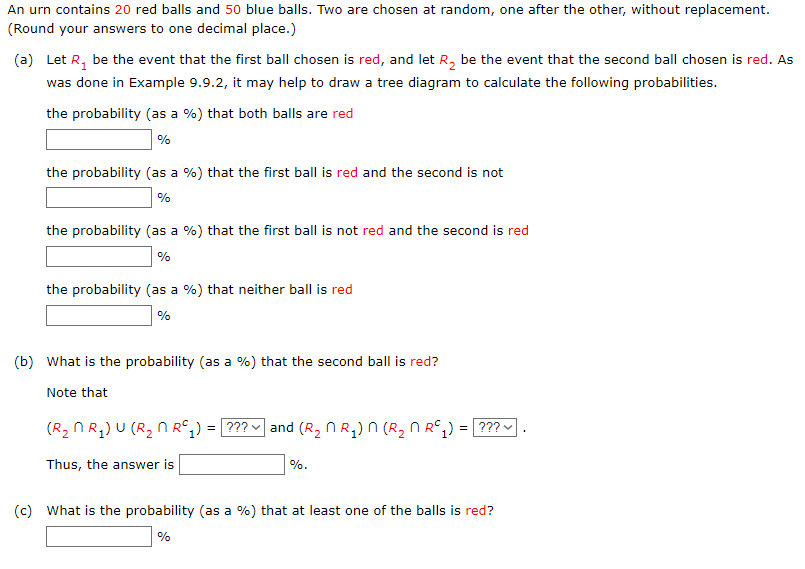An urn contains 20 red balls and 50 blue balls. Two are chosen at random, one after the other, without replacement. (Round your answers to one decimal place.) (a) Let R, be the event that the first ball chosen is red, and let R, be the event that the second ball chosen is red. As was done in Example 9.9.2, it may help to draw a tree diagram to calculate the following probabilities. the probability (as a %) that both balls are red the probability (as a %) that the first ball is red and the second is not the probability (as a %) that the first ball is not red and the second is red % the probability (as a %) that neither ball is red % (b) What is the probability (as a %) that the second ball is red? Note that (R2 N R,) U (R2 N R°;) = [??? - and (R, N R;) n (R2 N R°,) = ??? -. Thus, the answer is %. (c) What is the probability (as a %) that at least one of the balls is red?
An urn contains 20 red balls and 50 blue balls. Two are chosen at random, one after the other, without replacement. (Round your answers to one decimal place.) (a) Let R, be the event that the first ball chosen is red, and let R, be the event that the second ball chosen is red. As was done in Example 9.9.2, it may help to draw a tree diagram to calculate the following probabilities. the probability (as a %) that both balls are red the probability (as a %) that the first ball is red and the second is not the probability (as a %) that the first ball is not red and the second is red % the probability (as a %) that neither ball is red % (b) What is the probability (as a %) that the second ball is red? Note that (R2 N R,) U (R2 N R°;) = [??? - and (R, N R;) n (R2 N R°,) = ??? -. Thus, the answer is %. (c) What is the probability (as a %) that at least one of the balls is red?
College Algebra
7th Edition
ISBN:9781305115545
Author:James Stewart, Lothar Redlin, Saleem Watson
Publisher:James Stewart, Lothar Redlin, Saleem Watson
Chapter9: Counting And Probability
Section9.2: Probability
Problem 32E: Two balls are drawn at random from the jar. Find the following conditional probabilities. (a) The...
Related questions
Question
100%
This question is for Discrete Math

Transcribed Image Text:An urn contains 20 red balls and 50 blue balls. Two are chosen at random, one after the other, without replacement.
(Round your answers to one decimal place.)
(a) Let R, be the event that the first ball chosen is red, and let R, be the event that the second ball chosen is red. As
was done in Example 9.9.2, it may help to draw a tree diagram to calculate the following probabilities.
the probability (as a %) that both balls are red
the probability (as a %) that the first ball is red and the second is not
the probability (as a %) that the first ball is not red and the second is red
%
the probability (as a %) that neither ball is red
%
(b) What is the probability (as a %) that the second ball is red?
Note that
(R2 N R,) U (R2 N R°;) = [??? - and (R, N R;) n (R2 N R°,) = ??? -.
Thus, the answer is
%.
(c) What is the probability (as a %) that at least one of the balls is red?
Expert Solution
This question has been solved!
Explore an expertly crafted, step-by-step solution for a thorough understanding of key concepts.
This is a popular solution!
Trending now
This is a popular solution!
Step by step
Solved in 2 steps with 2 images

Recommended textbooks for you

College Algebra
Algebra
ISBN:
9781305115545
Author:
James Stewart, Lothar Redlin, Saleem Watson
Publisher:
Cengage Learning

College Algebra
Algebra
ISBN:
9781305115545
Author:
James Stewart, Lothar Redlin, Saleem Watson
Publisher:
Cengage Learning